Overview
This guide for Fellowship Program Directors provides you with documentation, videos, and other assistance to get started with Outcomes. While we continue to build on the content available here, feel free to contact our Support team with any additional questions.
Outcomes is a cloud-based admissions management platform that provides you with tools to streamline your admissions processes. Through these tools, you can:
- Manage each application as it progresses through the admissions cycle.
- Manage collective groups of applications.
- Obtain holistic views of applicant pools.
- Take full advantage of applicant data to make the best admissions decisions.
- Communicate with applicants and other key contacts.
Contact Support
For product and technical assistance, contact us by email at outcomessupport@liaisonedu.com or by phone at 617-221-7838. Note the following:
- Hours of operation: Monday – Friday, 9 AM – 8 PM ET.
- We typically provide responses to emails within two business days; however, response times can take up to three business days when we’re at our busiest.
- To ensure that you receive all our email messages, add our email address to your Safe Sender list.
Please note that our offices generally observe the following holidays, which may impact our customer service hours.
- New Year's Day
- Martin Luther King Jr. Day
- Presidents' Day
- Memorial Day
- Juneteenth
- Independence Day
- Labor Day
- Columbus / Indigenous Peoples' Day
- Thanksgiving
- Day after Thanksgiving
- Christmas Day
System Status
Visit our Status Page to view and subscribe to system status updates.
APPA CAS Webinar: Top 10 Things to Get You Started in Outcomes
Working with the Dashboard
After logging in to Outcomes, you'll see your Dashboard. The Dashboard is designed to show you charts that provide information about your applications, reviews, or other things most relevant to you.

Where desired, you can edit your Dashboard to add, remove, or adjust the charts.
Configuring Users and Roles
In Outcomes, as you add new users, you can establish Roles for different people who need to accomplish different tasks throughout your admissions process.
Think of the different users at your institution that will need to work with the software. Consider what limitations to their access may need to be implemented. If there are any groups of users who will need similar access, you can build Roles, allowing you to apply the same set of permissions to the entire group.
Assigning Applications with Tags
To assign applications in Outcomes without using Evaluation Forms and Phases, you may decide to work with Tags or Tasks.
Watch this video to learn how you can incorporate Tags or Tasks with your application review process. You'll learn:
- How to assign applications using Tags - 0:23
- How to assign applications using Tasks - 7:03
Tags are labels that you can place on applications to categorize them for any purpose. One way of working with Tags is to create Tags that indicate which reviewer should work with an application. Once the reviewer has completed their review, they can use the comments tab or add other Tags to indicate the results of their review.
To assign reviews using Tags:
- Go to the Applications View and find an application you wish to assign.
- From the Information Panel on the right, click the plus sign under Tags.
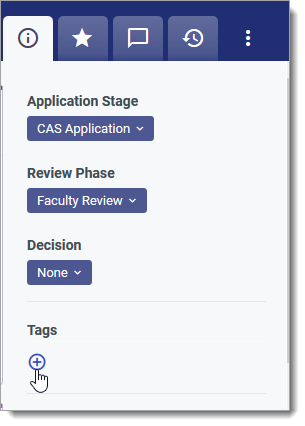
- Start typing to name the Tag. You can choose a name that associates the application with the appropriate reviewer (e.g., Barry, Review Group 1, or November 15th Reviews).
- Once you've created a Tag on one application, that Tag becomes available to use on other applications. So to use the Tag again, click on the plus sign and select the Tag from the list.

To save time, Tags can also be created and assigned in batch from the Applications View. To do this:
- Navigate to the Applications View and click the checkboxes next to the applications you wish to Tag.
- When the Batch Action menu appears, select Tag.
- Type to create a new tag, or select the existing Tag(s) you wish to apply and click Update Tags.

After Tags have been created, you can group them for reviewers, interviewers, or others to see which applications they should work with.
Assigning Applications with Tasks
As noted above, another way of indicating which applications need some action taken on them is by creating Tasks. Watch the video for guidance, or continue reading for written instructions.
You can use tasks to assign reviewers to applications individually. To do this:
- Go to the Tasks View by clicking Tasks from the Navigation Menu.
- Click the Create Task icon.

- Select an Assignee, Due Date, and an Application to assign. Only one application can be assigned as a Task at a time. Use the Description field to indicate what should be done (e.g., "Complete a Review" or "Review the applicant's Assessment Hours").
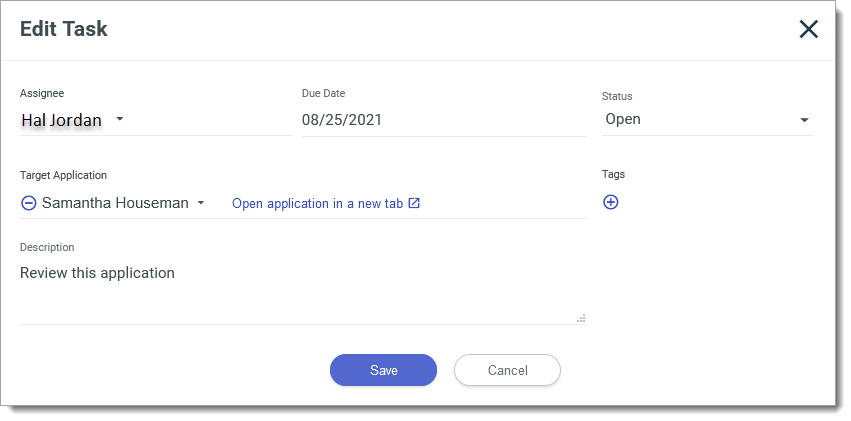
- Click Create to save the Task.
- Any user with access to Tasks can now navigate to the Tasks view and see which applications are assigned to them. They can also use filters to isolate specific Tasks.
- Once a reviewer has completed their review, where applicable, they can enter their results in the Comments tab of the application and mark the Task as complete.
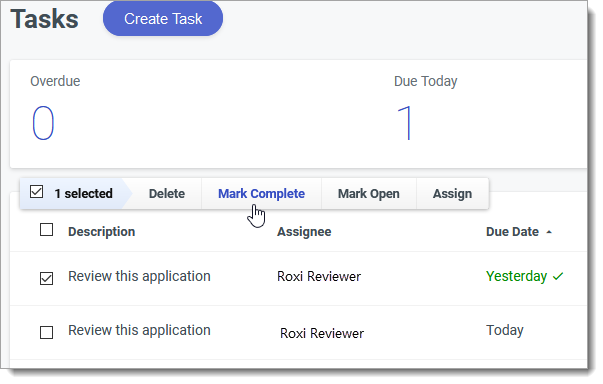
Exporting Review Results
If you're using Evaluation Forms to record the results of your reviews or interviews, you can export the results into a PDF. When generating Application PDFs, the Evaluation Form results appear in a section called Evaluations.
Exporting the Default PDF
The quickest way of exporting review results is to export the Default PDF. There's no configuration required to generate this file, which includes a cover page, attachments, documents, and other applicant data.
Since this PDF document includes the entire application, this method allows you to quickly create an export file without needing to select which sections you want to include. To export a Default PDF:
- Navigate to the Applications View.
- Click the checkbox near any application you wish to include in your export.
- Click Export from the Batch Actions menu
- Click Generate next to Default PDF.

- A window appears confirming that your export is being processed. Wait for the export to finish and click the link to download it here, or dismiss the window.

- If you dismiss the window or need to access the export again, click Downloads from the Activity section to download the file later.
- The Evaluations section of the PDF file includes all review forms completed on the Application, along with the Reviewer's name, field responses, and Datestamp. The Evaluations are separated by headings displaying the name of the Evaluation Form used for the review.
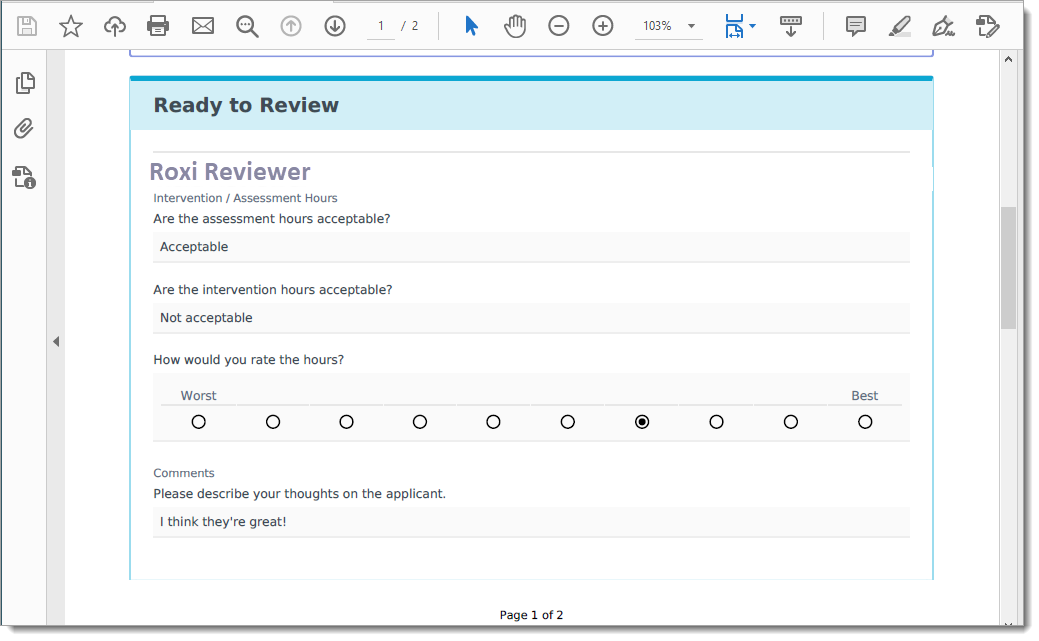
You can also generate the Default PDF for an individual application by navigating to the desired application record, and selecting Export from the More Options (three dots) menu.
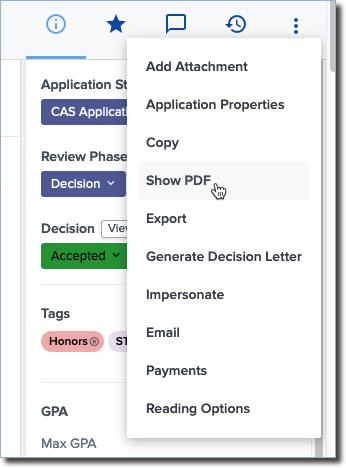
Configuring an Export Template with Review Results
If you don't want to export the entire application as described above, another way of exporting review results is to create a customized export file. Using this method, you can select the specific elements you wish to include in your PDF file. For example, you can configure a PDF export that only includes the Summary Page and Evaluation Form results. To configure an export file including review results:
- Go to the Import/Export section of the Settings menu and click Exports.

- Review the existing exports, or click Create Export to begin creating a new export file.

- Select PDF Export.

- Name the export file.
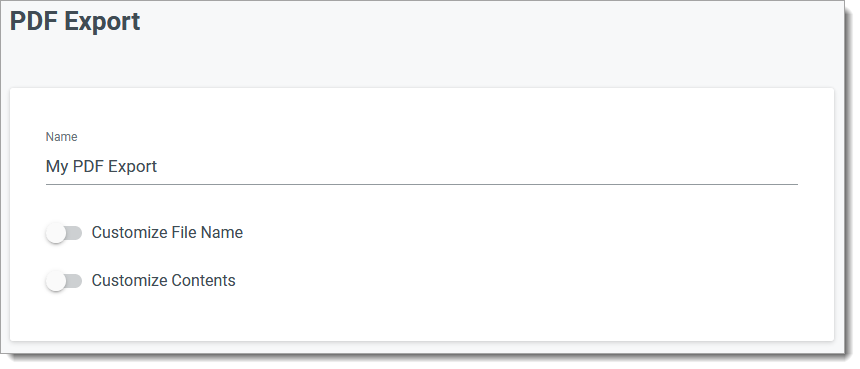
- Enable the Customize Contents option to establish which sections of the PDF you'd like to include. To include review results, make sure Evaluations is checked.

- Check and uncheck the sections as desired, then click Create Export at the bottom of the page.
- Once you've configured this export file, it becomes available to select when generating an export file.

- Once the files have generated, click the links to download them.

- The Evaluations section of the PDF file includes all review forms completed on the Application, along with the Reviewer's name, field responses, and Datestamp. The Evaluations are separated by headings displaying the name of the Evaluation Form used for the review.

Exporting Application Data
Outcomes allows you to design Exports so you can extract the application data you need into a spreadsheet, PDF, JSON, or zip file.
You may wish to create an applicant data download containing all application data, or you may wish to build an export template by selecting specific fields to include. This section focuses on exporting all application data, while the following section helps with exporting review and assignment data specifically.
Exporting All Application Data into a JSON File
The easiest way of extracting all applicant data into a single file is to use the Default JSON Export option. This option sends all the included applicants' data into a JSON file without any additional configuration. JSON is a format commonly used to transmit data from web applications but, unlike a Speadsheet Export, it isn't easily readable in Excel. Instead, JSON files are typically imported into another system. For a more readable file containing all application data without additional configuration, you may choose to export the Default PDF file.
To create a Default JSON Export file:
- Navigate to the Applications View.
- Use Segments, Filters, or the Search bar to find the applications you wish to include in your export. Select them individually or use the top checkbox to select all applications.
- Click Export from the Batch Actions menu.
- Click Generate next to Default JSON.
- A window appears confirming that your export is being processed. Wait for the export to finish and click the link to download it here, or dismiss the window.

- If you dismiss the window or need to access the export again, go to the Downloads in the Activity section to download the file later.
Exporting All Application Data into an Excel File
If you prefer to export all application data into an Excel file, you can do this by configuring a Spreadsheet Export Template with all fields included. To do this:
- Go to the Import/Export section of the Settings menu and click Exports.

- Click Create Export to begin creating a new export file.

- Click Tabular/Spreadsheet.
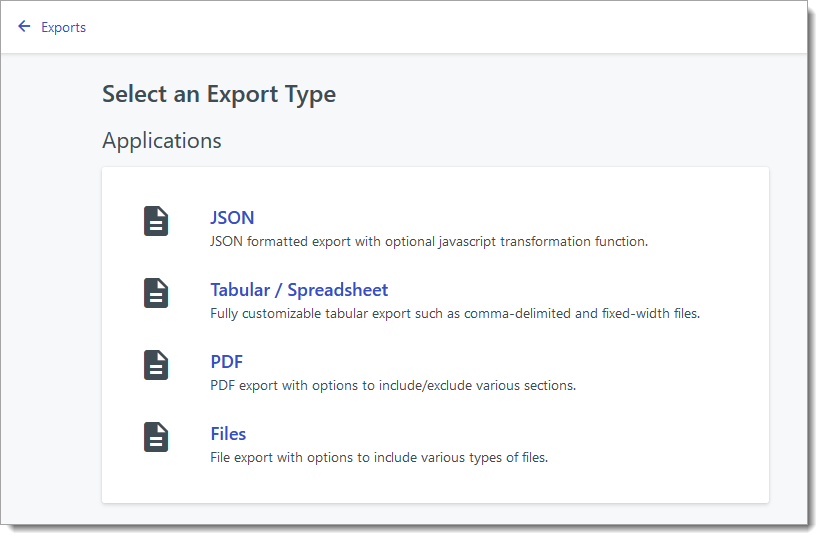
- Name the export file, and select from the Comma Delimited, Tab Delimited, or Fixed Width style types. The most common option is Comma Delimited, but your needs may vary.
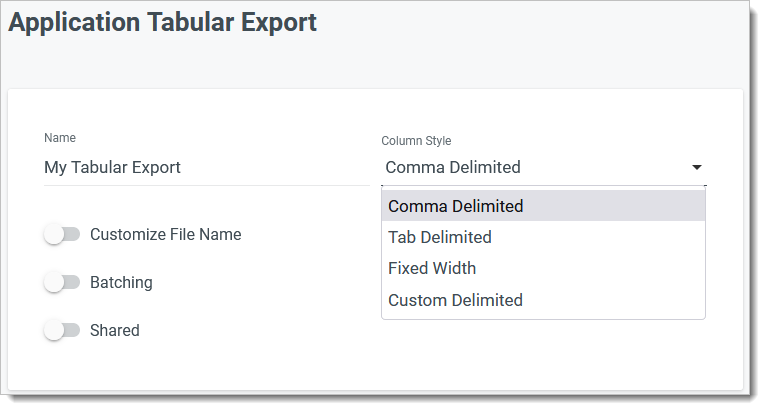
- In the Columns area, add the fields you wish to include in your export by finding them on the Available Fields panel and clicking to add them. You can also drag-and-drop them into your desired order.
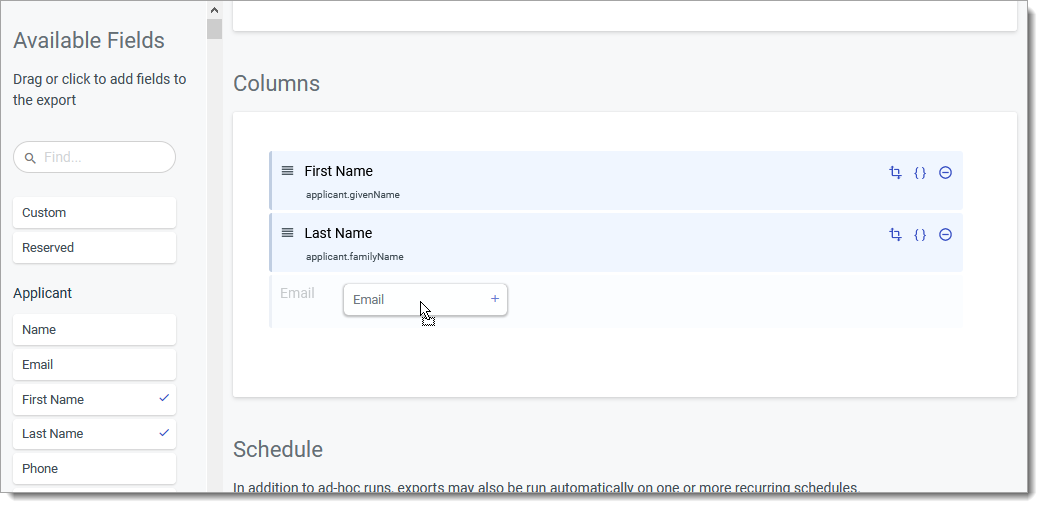
- Where applicable, click the plus sign near any section to add all of its fields. Fields you have already included appear with a checkmark beside them.

- For fields that involve multiple data points, a Pivot window appears allowing you to select which columns to include. To do this:
- Drag the desired columns from the left to the right.
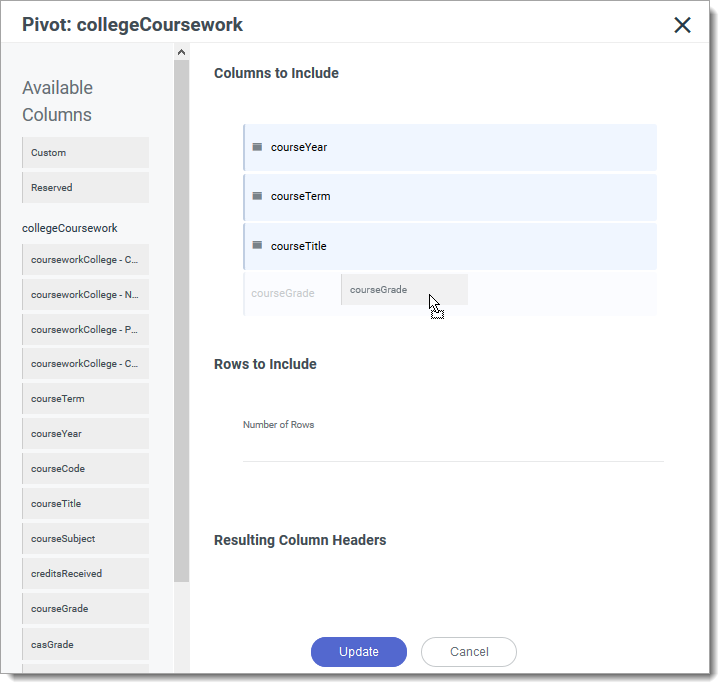
- Order them as desired.
- Select the number of rows you'd like to include. For example, for Colleges Attended, if you set this number to 5, five colleges and their corresponding data will be included in your export. The remaining data is excluded.
- Check the Resulting Column Headers section to review how your column headers will appear in the resulting export.
- Click Update to save your changes.
- To make changes to the selected fields once you've dismissed this window, click the Pivot Table icon on the corresponding field.

- When you’re done configuring the export, click Create Export.
Sending Emails to Applicants
Outcomes allows you to configure email templates to send to your applicants. You can send emails individually from the More Options menu in an application, or in batch from the Applications Grid.
While configuring email templates, you should also configure your Reply-to Address. This refers to the email address that will be used when your email recipients reply to your message. For example, if you have a shared inbox that all applicant emails should go to, you can set that email address as the reply-to address. If this option is not configured, you may not receive replies to your messages. To establish your Reply-to Address:
- Create a new email template or edit an existing template.
- Click Customize Email Headers.
- From here, use the Reply-to Address field to enter the email address of your choice.
- Use the Reply-to Name field to enter a name to associate with this email address (e.g., Demo University Admissions).
This name and email address will populate when a recipient attempts to reply to one of your messages.


























